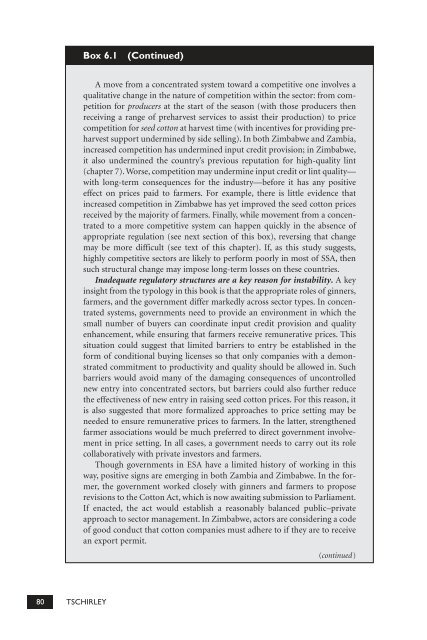Organization and Performance of Cotton Sectors in Africa ... - infoDev
Organization and Performance of Cotton Sectors in Africa ... - infoDev
Organization and Performance of Cotton Sectors in Africa ... - infoDev
You also want an ePaper? Increase the reach of your titles
YUMPU automatically turns print PDFs into web optimized ePapers that Google loves.
Box 6.1 (Cont<strong>in</strong>ued)A move from a concentrated system toward a competitive one <strong>in</strong>volves aqualitative change <strong>in</strong> the nature <strong>of</strong> competition with<strong>in</strong> the sector: from competitionfor producers at the start <strong>of</strong> the season (with those producers thenreceiv<strong>in</strong>g a range <strong>of</strong> preharvest services to assist their production) to pricecompetition for seed cotton at harvest time (with <strong>in</strong>centives for provid<strong>in</strong>g preharvestsupport underm<strong>in</strong>ed by side sell<strong>in</strong>g). In both Zimbabwe <strong>and</strong> Zambia,<strong>in</strong>creased competition has underm<strong>in</strong>ed <strong>in</strong>put credit provision; <strong>in</strong> Zimbabwe,it also underm<strong>in</strong>ed the country’s previous reputation for high-quality l<strong>in</strong>t(chapter 7). Worse, competition may underm<strong>in</strong>e <strong>in</strong>put credit or l<strong>in</strong>t quality—with long-term consequences for the <strong>in</strong>dustry—before it has any positiveeffect on prices paid to farmers. For example, there is little evidence that<strong>in</strong>creased competition <strong>in</strong> Zimbabwe has yet improved the seed cotton pricesreceived by the majority <strong>of</strong> farmers. F<strong>in</strong>ally, while movement from a concentratedto a more competitive system can happen quickly <strong>in</strong> the absence <strong>of</strong>appropriate regulation (see next section <strong>of</strong> this box), revers<strong>in</strong>g that changemay be more difficult (see text <strong>of</strong> this chapter). If, as this study suggests,highly competitive sectors are likely to perform poorly <strong>in</strong> most <strong>of</strong> SSA, thensuch structural change may impose long-term losses on these countries.Inadequate regulatory structures are a key reason for <strong>in</strong>stability. A key<strong>in</strong>sight from the typology <strong>in</strong> this book is that the appropriate roles <strong>of</strong> g<strong>in</strong>ners,farmers, <strong>and</strong> the government differ markedly across sector types. In concentratedsystems, governments need to provide an environment <strong>in</strong> which thesmall number <strong>of</strong> buyers can coord<strong>in</strong>ate <strong>in</strong>put credit provision <strong>and</strong> qualityenhancement, while ensur<strong>in</strong>g that farmers receive remunerative prices. Thissituation could suggest that limited barriers to entry be established <strong>in</strong> theform <strong>of</strong> conditional buy<strong>in</strong>g licenses so that only companies with a demonstratedcommitment to productivity <strong>and</strong> quality should be allowed <strong>in</strong>. Suchbarriers would avoid many <strong>of</strong> the damag<strong>in</strong>g consequences <strong>of</strong> uncontrollednew entry <strong>in</strong>to concentrated sectors, but barriers could also further reducethe effectiveness <strong>of</strong> new entry <strong>in</strong> rais<strong>in</strong>g seed cotton prices. For this reason, itis also suggested that more formalized approaches to price sett<strong>in</strong>g may beneeded to ensure remunerative prices to farmers. In the latter, strengthenedfarmer associations would be much preferred to direct government <strong>in</strong>volvement<strong>in</strong> price sett<strong>in</strong>g. In all cases, a government needs to carry out its rolecollaboratively with private <strong>in</strong>vestors <strong>and</strong> farmers.Though governments <strong>in</strong> ESA have a limited history <strong>of</strong> work<strong>in</strong>g <strong>in</strong> thisway, positive signs are emerg<strong>in</strong>g <strong>in</strong> both Zambia <strong>and</strong> Zimbabwe. In the former,the government worked closely with g<strong>in</strong>ners <strong>and</strong> farmers to proposerevisions to the <strong>Cotton</strong> Act, which is now await<strong>in</strong>g submission to Parliament.If enacted, the act would establish a reasonably balanced public–privateapproach to sector management. In Zimbabwe, actors are consider<strong>in</strong>g a code<strong>of</strong> good conduct that cotton companies must adhere to if they are to receivean export permit.(cont<strong>in</strong>ued)80 TSCHIRLEY
















